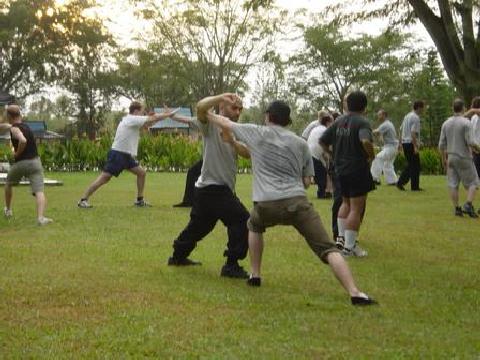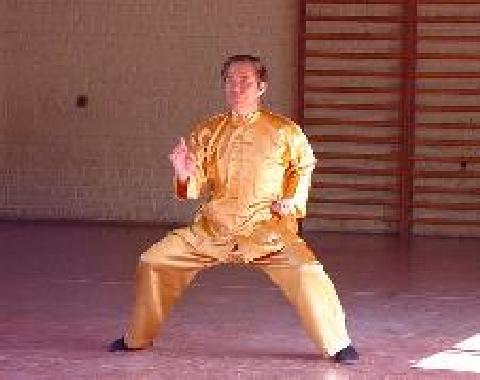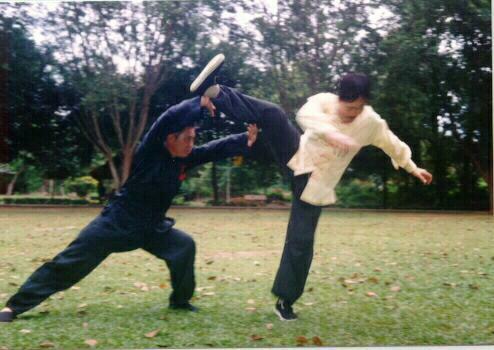May 2005 (Part 3)
SELECTION OF QUESTIONS AND ANSWERS

Sparring using typical kungfu patterns, as shown here during the Intensive Shaolin Kungfu Course in Malaysia in November 2004, is an essential aspect of genuine, traditional Shaolin Kungfu. In the foreground, Mohamed from England attacks with “Hang a Golden Star at a Corner”, and Innes from Scotland responds with “Immortal Emerges from Cave”.
Question 1
I have been fighting a flu, bad cough and sinusitis for more than 3 weeks. On the forum, Antonius advised me to ask you, Sifu, for advice. I refrained from doing so all this time because I did not want to “complain". Also, I read your replies to Hubert and I know that I must be patient for the cleansing to do its work.
Actually, I have gone past the stage of discouragement when I thought my qigong practice was doing only harm. Right now, I enjoy my practice joyfully daily.
— Christopher, Singapore
Answer
I am concerned about your long bout of coughing, though such cases are not uncommon amongst my best students, like Anthony and Hubert, where they underwent very thorough and deep cleansing. Recently I met Hubert in England and Scotland, and he was very happy that he had gone through this period of deep cleansing.
While the cleansing is good, I often wonder whether it is too drastic. Indeed I have given serious thought of purposely lowering the level of my intensive teaching so that these dedicated students would not “suffer” such drastic reactions.
In our human scale, such deep cleansing lasting several months, like what Anthony and Hubert underwent, takes quite a long time, but in the cosmic scale it is like a blink of the eye. You may be happy to know that you are now cleansing away “dirt” (or “sin” in Christian terms) in a few months what it would normally take most people many lifetimes to do. In Buddhist terms, it is erasing bad karma. One has to be perfectly pure, i.e. without even a spec of dirt, before he can return to God. Even if he may not be ready, or even interested, to return to God yet, being purified spiritually certainly has many benefits even in our phenomenal world.
It is legitimate to ask whether what I have said about deep cleansing is true. As far as I know from my knowledge and experience, it is, although in practice it is possible that I may make a wrong judgment mistaking symptoms from wrong training for symptoms from deep cleansing, and this is where I have to be extremely careful. The golden rule is that if you feel pleasant after the training, even though the symptoms may be drastic, the training is correct.
There is also a thin line separating wrong training and too much or too intense training. For our purpose here, I would call “too much or too intense training”, “wrong training” though the techniques and skills involved are correct. This is probably the case with our dedicated students, including you.
It is easy to over train as our arts are of such a high level. Indeed we have now come to a point when many of us in Shaolin Wahnam are embarrassed to mention this high level factor so as to avoid hurting the sensitivity, and sometimes the wrath, of many other people who are so used to (what is to us) low level arts. Understandably many people will regard us as being extremely conceited when we mention that we often achieve in a few days what many other people may take many years, but this is true.
For example, a student who just completed a five-day Personalized Chi Kung Course (he wishes to remain anonymous because of his high public profile) can now tap energy from the cosmos and direct it to wherever he wants inside his body. He told me three days ago that he found his room so smelly when he woke up because he had cleansed out so much toxic waste from his body.
In a training session two days ago he directed chi to his lungs to cleanse out stale air that had been in the recess of his lungs for years. He felt a very strong bitter taste as the stale air was purged out. Yesterday, while practicing an advanced exercise, he felt a strong current of energy rushing up his spine to the crown of his head, so strong that he became scared. It was a kundalini effect — and it happened after only a few days of intensed chi kung practice. Most people reading this will not beleive it or say we are lying.
Question 2
I understand it is not reasonable for Sifu to diagnose my problem over an email but I would like to know why my illness is so severe, in fact much more severe than my friends and colleagues who do not practice qigong.
Also, I would have thought that after 8 months of constant practice, I would have gotten rid of my constant vulnerability to flu and sinus problems. Is there any way I can check if I am not performing our high-level qigong properly?
Answer
In your case, I would recommend that you substantially slow down your practice and purposely make your training low-level. (“Low-level” here is relatively to what we normally practice; compared to what other people practice, it is still very high level.) In your chi flow, for example, do not operate at the mind level.
Do not, for example, consciously tap energy from the cosmos and enhance both the volume and rhythm of your flow. Just enjoy your chi flow at the form level. In other words, just let your chi move your physical body, without using your mind to influence the speed, direction, volume and nature of the flow or movement. However, if the flow becomes too fast or powerful, you should use your mind to slow it down.
Your high level chi kung skills are transferable. Hence, if you practice “chi kung” for 15 minutes and Taijiquan for an hour, you may be doing high level chi kung for an hour and fifteen minutes, which is a lot. As in chi kung, while practicing Taijiquan you should slow down the mind and energy aspects, and focus on the form aspects. For example, instead of directing your energy to flow along certain meridians or increasing your internal force, you should foucs on correctness of forms and elegance of movement.
After some time, which may be a few months or two or three years later, depending on how well your physical body takes your deep emotional, mental and spiritual cleansing, you can gradually proress to the energy and mind aspects. Remember that what you have learnt at the Intensive Chi Kung Course for a few days is meant to be spread out in your own practice over a few years.
Question 3
My father suffered from much pain after his operation. He was distressed that something was taken out from his body. But the good thing is he is now ready to give up his vices and change into a better lifestyle.
Answer
I am sorry to hear about your father's after effect of the operation. What he needs now is not just release from physical but also from spiritual (including emotional and mental) pain.
Tactfully tell him he can take comfort from the fact that a physical defect in his body has been successfully removed and that chi flow, which you can show him how to do, can compensate for the functions of the removed organ. Tell him that it is a blessing in disguise, as he is now ready to give up his vices and change to a better lifestyle. Assure him that a wonderful life is just awaiting him. More significantly, spend some quality time with him. He will appreciate it more than receiving $10,000 as a present from you.

Another essential aspect of genuine, traditional Shaolin Kungfu is internal force training. Here Sifu Wong demonstrates a signature method of internal force training in Shaolin Wahanm, called “One Finger Shooting Zen”.
Question 4
What can I do to help my father to release his pain?
Answer
Here are four methods you can help him to release pain.
Perform “Lifting the Sky” about 10 to 20 times. Then place your palm about 6 inches above the area of his pain. Rotate your palm starting from a central point outward. (You can rotate in clockwise or anti-closewise direction.) While rotating your palm, gently think that good energy from your palm flow into your father's body to clear the pain. Perform this for about 5 to 10 minutes.
You may perform as many times a day as you like, but after each session, do the following. Flick your palm as if you are flicking away water on a wet palm. This is to flick away any bad energy that you may have picked up. Then go to a suitable place (away from the hospital bed) to perform “Lifting the Sky” about 20 times to replenish the energy you have spent.
Secondly, as you practice chi kung, gently think of your father, gently think that your chi flow clears away his pain. God works in mysterious ways, and this is an example.
Thirdly, ask your father to breathe in fully but gently through his nose, and then breathe out loudly but in a gentle manner through his mouth. As he breathes out he has a gentle thought that his pain is being flushed out by the out-going breath. He can do this whenever he wishes, but especially when he is in pain. It is best if he can do this in open space with good circulating air, but it is also permissble to do it in his hospital bed.
Fourthly, when he is able, teach him “Lifting the Sky”. Teach him the form and the breathing, but leave out the visualization. Unless the mistakes are serious, like tensing his muscles or breathing forcefully, ignore his mistakes so that he can just enjoy the exercise without someone “nagging” him on correct techniques and skills. He should perform the pattern about 30 times. Then just stand upright, be relaxed and do nothing. “Do nothing” means not thinking of anything. It also means not tensing his muscles if his chi moves him gently. Enjoy the tranquility for about 5 minutes, then complete the exercise.
Question 5
Is the care of teeth and gums a part of Chinese medicine? None of the books on Chinese medicine that I have read mentioned oral hygiene or dentistry.
— Marcus, USA
Answer
Of course the care of teeth and gums has been a part of traditional Chinese medicine, as its basic philosophy is to take care of the health — not just the illness — of the patient as a whole person.
Dentistry became a specialty in traditional Chinese medicine as early as the Tang Dynasty, which is more than 1200 years ago, long before Western medicine became a coherent system. Chinese dentists at that time already extracted and filled teeth successfully.
Modern dentists could learn a thing or two from the Chinese, especially in cases when there are no apparent causes. If a patient complains of toothache and examination shows that the tooth is clincically alright, an effective way to eliminate the pain is to press at the “hegu” vital point located between the thumb and index finger.
Surprising it may be to many people, Western dentists and doctors still have difficulty treating a simple but common problem like ulcers in the mouth. Besides cleaning the mouth with disinfectant or prescribing a dose of antibiotics to prevent infection, Western dentists and doctors normally let the ulcers heel themselves. But a Chinese herbal mixture in the form of powder called “hou feng san” is excellent in healing mouth ulcers.

Combat application using typical Taijiquan patterns is an essential aspect of genuine, traditional Taijiquan. Sifu Wong applied the Taijiquan pattern, "Dodge and Release Arm" to counter a kick from Sifu Goh Kok Hin.
Question 6
A fellow Tai Chi student has read that “Shaolin disciples learn Wu style Tai Chi Chuan after attaining an advanced level of Shaolin Kung Fu.” Is this true?
— Steve, USA
Answer
It is true that advanced Shaolin practitioners, even masters, learn Tai Chi Chuan after having practiced Shaolin Kungfu for many years. It is also true the other way round, i.e. advanced Tai Chi Chuan practitioners learn Shaolin Kungfu, though I think that the number of Shaolin Kungfu practitioners turning to Tai Chi Chuan is more.
However, in our school, Shaolin Wahnam, the trend is generally Tai Chi Chuan practitioners wanting to change to Shaolin Kungfu. I often have to persuade them to stay in Tai Chi Chuan. This is especially so with one of our best instructors. (I shall not reveal his name unless he wants to identify himself.) I am glad he heeds my advice that Tai Chi Chuan needs him to help preserve the wonderful art. Indeed, it would be a great loss to Tai Chi Chuan had he stopped teaching Tai Chi Chuan to practice Shaolin Kungfu.
Question 7
If so, which Wu style?
Answer
I do not know which Wu Style Tai Chi Chuan you friend referred to, but it does not really matter. Either Wu styles or any style of Tai Chi Chuan will serve the purposes of these Shaolin practitioners.
Question 8
Why do they do so only after reaching an advanced standard?
Answer
The main reason why many Shaolin practitioners, as well as martial artists of other systems, turn to Tai Chi Chuan after reaching an “advanced” standard is because they find, or hope to find, something in Tai Chi Chuan that they cannot find in Shaolin Kungfu.
To most of them this “something” is internal force. To some it is their belief that the “gentleness” in Tai Chi Chuan is more appropriate in helping them to attain longeviity. I recall that years ago a kungfu classmate told me he practiced Shaolin Kungfu for self defence, but when he grew old he would practice Tai Chi Chuan to maintain life.
I use inverted commas for “advanced” above because it is subjective as well as open to different interpretation. To many uninformed persons, someone who has practiced an art for twenty years is advanced, even though he may have practiced badly. What is more subtle is that he may have practiced his art well but at a low level. In other words he can be a real master of a low level art.
Take an example of someone who has practiced Shaolin Kungfu for twenty years and is well known in kungfu circles. What he practices is genuine Shaolin kungfu forms, but he is unable to use his kungfu forms for combat though he is actually a formidable fitgher using Kickboxing, and he has no internal force though he is powerful using muscular strength. Most people would regard him as a Shaolin master.
But strictly speaking, he is a master of Shaolin kungfu forms, Kickboxing fighting and muscular strength. If we accept combat application using Shaolin forms and internal force as essential criteria for genuine, traditional Shaolin Kungfu, it would be debatable whether it is right to regard him as a genuine, traditional Shaolin master. This is a sensitive issue but today many Shaolin masters fall into this category. It is also this huge category of advanced Shaolin practitioners as well as masters of external martial arts who turn to Tai Chi Chuan in their advanced years.
Unfortunately, many of them are disappointed because what they often learn from Tai Chi Chuan masters are merely external Tai Chi Chuan forms. These Tai Chi Chuan masters are in the same boat as the Shaolin masters. They may have practiced genuine Tai Chi Chuan forms for twenty years, and have read about Tai Chi Chuan philosophy but they still cannot apply Tai Chi Chuan for combat and have no internal force.
In my opinion, if someone has practiced genuine, traditional Shaolin Kungfu to an advanced level, it is unlikely he will turn to Tai Chi Chuan for further development because all that can be found in Tai Chi Chuan is also found in genuine, traditional Shaolin Kungfu. Today, the term “Shaolin Kungfu” has undergone drastic changes. Some people whose forms are obviously Kickboxing and whose force training is mainly running and weight-lifting, may vehemently proclaim that theirs is genuine Shaolin Kungfu.
LINKS
Selected Reading
- Combat Sequences of Wahnam Taijiquan
- What is Wahnam Taijiquan
- Experiencing Satori at the Blue Mountain — Laura Fernández Garrido
- A Comparison of Shaolin Kungfu and Taijiquan
- Great Benefits — Joan Browne
